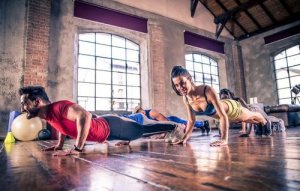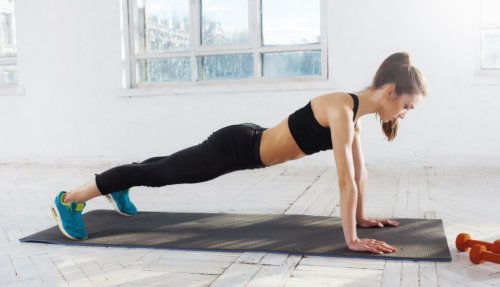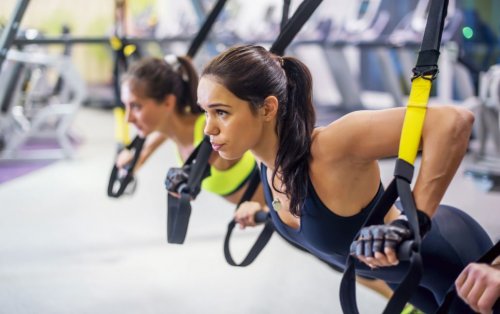Equipment-Free Chest Exercises

Many athletes want to have a chiseled chest. Having defined chest muscles makes your body look strong and gives your athletic performance a boost. If you want to know how to train them at home, take a look at the equipment-free chest exercises in this article.
While the bench press’s effectiveness is almost impossible to replace, equipment-free chest exercises are also a good alternative. The advantage is that they can be done anywhere. What’s more, you do not need any equipment, meaning all you need is your body to perform these exercises.
Why target your chest?
This topic should be of interest to both men and women. Chest muscles not only make you look athletic, but they are also beneficial when it comes to strength and body posture.
The pectoralis major and the pectoralis minor are the two muscles that make up “chest” muscles. They are important since they enable you to move and carry weight by working with the shoulders, arms, and back. As such, they are associated with a person’s strength.
What’s more, training them gives you better muscular and bone stability. In sports practice, targeting chest muscles can increase your strength, power, and endurance. If that is not enough, they also help to prevent injuries.
Performing Equipment-Free Chest Exercises
First, we need to clarify that the length of the sessions and each set depends on the person’s physical fitness. So, if you are going to do equipment-free chest exercises, you should assess your limits to avoid overdoing it. You can do three or four sets of 10 to 15 reps daily. Rest for about two to three minutes between each set.
1.- Push-ups

These are your traditional push-ups. First, lie face down on the ground, with the tips of your feet and the palms of your hands pressing down. Your hands should be shoulder-width apart. Next, push your body until you have extended your arms and return to the starting position.
Keep two important things in mind: your body cannot touch the ground and you should never curve your back. It should always stay straight.
2.- Triangle push-ups
This is a variation of the previous exercise. For this one, instead of placing your arms shoulder-width apart, bring them closer and in a close-hand position. Your hands should be close enough to form a triangle or diamond with your thumbs and index fingers. The movement remains the same; push your body weight upwards without letting your body touch the ground.
3.- Asymmetrical push-up
The idea here is to have your point of support at a different height. To do that, you can place a push-up bar, books, box, or any other item that can help with stability.
Next, do a normal push up with one arm on your chosen item, meaning it will be higher than the other arm. Do one set on each arm.
4.- Suspended push-ups

For this next move, you should have elastic bands or TRX bands. You can target your chest by standing with the bands in your hands. The bands should be hanging from the ceiling or somewhere that is higher than your body.
Bring your body forward while slightly lifting your heels from the ground. Try to bring yourself to a 45-55 degree angle. Return to your starting position by using your chest muscles to push your body backwards.
5.- Tempo pushups 3-1
This push-up involves adding power to the rising part of a normal or any other type of push-up. As such, you should push your body upwards as fast as you can. Then, slowly lower your body for three seconds.
6.- Inverted push-ups
For this next example, your feet have to be higher than the rest of your body. To this end, you can place a bench or chair behind you.
Once you are in the right position, do a normal push-up as previously described. We recommend keeping your arms shoulder-width apart to help with balance.
Tips for starting out and progressing
Not everyone will use the same effort when exercising. As such, not every person will start with the same intensity. In addition, some may have to practice these exercises until they can do them well.
A good tip is to start equipment-free chest exercises by supporting your body weight on your knees. This can be especially useful for the elderly, overweight individuals, and those with muscle pain. You can move on to other variations once you have mastered knee push-ups.
Ideally, you should gradually increase the number of repetitions and series. In other words, once you have reached 20 repetitions, do 25 or 30 during your next session.
Finally, while paying attention to your back, you should do the same thing that you would do for other exercises. This includes warm-ups, minding your body’s form, and stretching properly once you have finished. Remember, it is better to do exercises at a low intensity with a good technique, rather than at a high intensity with a bad technique.
Many athletes want to have a chiseled chest. Having defined chest muscles makes your body look strong and gives your athletic performance a boost. If you want to know how to train them at home, take a look at the equipment-free chest exercises in this article.
While the bench press’s effectiveness is almost impossible to replace, equipment-free chest exercises are also a good alternative. The advantage is that they can be done anywhere. What’s more, you do not need any equipment, meaning all you need is your body to perform these exercises.
Why target your chest?
This topic should be of interest to both men and women. Chest muscles not only make you look athletic, but they are also beneficial when it comes to strength and body posture.
The pectoralis major and the pectoralis minor are the two muscles that make up “chest” muscles. They are important since they enable you to move and carry weight by working with the shoulders, arms, and back. As such, they are associated with a person’s strength.
What’s more, training them gives you better muscular and bone stability. In sports practice, targeting chest muscles can increase your strength, power, and endurance. If that is not enough, they also help to prevent injuries.
Performing Equipment-Free Chest Exercises
First, we need to clarify that the length of the sessions and each set depends on the person’s physical fitness. So, if you are going to do equipment-free chest exercises, you should assess your limits to avoid overdoing it. You can do three or four sets of 10 to 15 reps daily. Rest for about two to three minutes between each set.
1.- Push-ups

These are your traditional push-ups. First, lie face down on the ground, with the tips of your feet and the palms of your hands pressing down. Your hands should be shoulder-width apart. Next, push your body until you have extended your arms and return to the starting position.
Keep two important things in mind: your body cannot touch the ground and you should never curve your back. It should always stay straight.
2.- Triangle push-ups
This is a variation of the previous exercise. For this one, instead of placing your arms shoulder-width apart, bring them closer and in a close-hand position. Your hands should be close enough to form a triangle or diamond with your thumbs and index fingers. The movement remains the same; push your body weight upwards without letting your body touch the ground.
3.- Asymmetrical push-up
The idea here is to have your point of support at a different height. To do that, you can place a push-up bar, books, box, or any other item that can help with stability.
Next, do a normal push up with one arm on your chosen item, meaning it will be higher than the other arm. Do one set on each arm.
4.- Suspended push-ups

For this next move, you should have elastic bands or TRX bands. You can target your chest by standing with the bands in your hands. The bands should be hanging from the ceiling or somewhere that is higher than your body.
Bring your body forward while slightly lifting your heels from the ground. Try to bring yourself to a 45-55 degree angle. Return to your starting position by using your chest muscles to push your body backwards.
5.- Tempo pushups 3-1
This push-up involves adding power to the rising part of a normal or any other type of push-up. As such, you should push your body upwards as fast as you can. Then, slowly lower your body for three seconds.
6.- Inverted push-ups
For this next example, your feet have to be higher than the rest of your body. To this end, you can place a bench or chair behind you.
Once you are in the right position, do a normal push-up as previously described. We recommend keeping your arms shoulder-width apart to help with balance.
Tips for starting out and progressing
Not everyone will use the same effort when exercising. As such, not every person will start with the same intensity. In addition, some may have to practice these exercises until they can do them well.
A good tip is to start equipment-free chest exercises by supporting your body weight on your knees. This can be especially useful for the elderly, overweight individuals, and those with muscle pain. You can move on to other variations once you have mastered knee push-ups.
Ideally, you should gradually increase the number of repetitions and series. In other words, once you have reached 20 repetitions, do 25 or 30 during your next session.
Finally, while paying attention to your back, you should do the same thing that you would do for other exercises. This includes warm-ups, minding your body’s form, and stretching properly once you have finished. Remember, it is better to do exercises at a low intensity with a good technique, rather than at a high intensity with a bad technique.
This text is provided for informational purposes only and does not replace consultation with a professional. If in doubt, consult your specialist.








